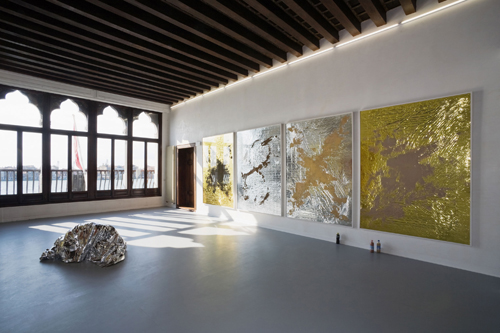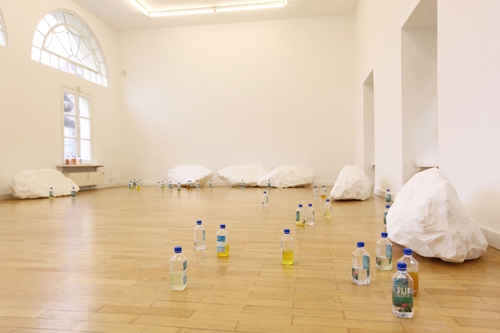Pamela Rosenkranz
Water bottles, pills and emergency blankets
Water bottles, pills and emergency blankets

There is a kind of deliberate vanishing at the centre of Pamela Rosenkranz’s body of work, a specific absence — both corporeal and spiritual — that paradoxically makes the subjective body and mind loom up through her works larger than ever. The artists practice is predicated on such paradox, though. Her conceptually driven, abstract sculptures, works on paper, videos and installations nearly always reference or confront you with the figurative: its trace, its loss, its needs, its commercialism, its elimination. See, for example, her 2010 ‘More Core’ series of photograms of tiny, coloured pills (body and mind manipulators like pain relievers, antidepressants and energy enhancers), which glow luridly against their dark fields like alien eyes emerging from the void. Or her ‘Firm Being‘ (2009-ongoing) series of variously branded plastic water bottles filled with silicon pigmented to skin-like hues, which expertly satirize water company ads like FIJI’s: ‘Untouched by Man. Until you drink it.’
Or take, as the most explicit example, Rosenkranz’s repeated abstract motif of body-printing on blanket-sized pieces of foil or spandex or free-standing Plexiglas. Its a technique the artist has seized from Yves Klein’s ‘Anthropométries’ (Anthropometries, 1960-2) — his paint-covered, nude, female models impressed publicly upon canvas and then abstracted and abandoned. But her ‘figure‘ is dressed, its tawny imprint more allusion than actually figured, and the subjective violence of its art historical gesture is at once automatic and patently ironic. Rosenkranz first employed this motif in ‘Our Sun’, a solo exhibition at the Istituto Svizzero di Roma’s space in Venice in 2009. The show featured two series that utilized emergency blankets, metallic silver on one side for cooling the body, glittery gold on the other for heating as either canvasses for framed paintings or material for floor sculptures. These gorgeous, blinding works were accompanied by the artists water bottles, scattered over the floor, and a video projection that soaked one large wall in cerulean and green hues, resolving themselves into a moving image of the Earth from space. A vertical axis dividing the image of the Earth created symmetrical reflections like a constantly morphing Rorschach test — an odd view of our planets regenerational capacities. The show was a coolly sceptical take on Venices fabled ‘light and water‘ aesthetic, subversively clinical even while the elegant works glittered and glowed.

For her Venice exhibition catalogue, Rosenkranz commissioned a text by Iranian philosopher Reza Negarestani, whose speculative fictions and radical ideas about ‘heliocentric slavery‘ and ‘aquatic capitalism‘ were an influence on her conception of Venices complicated present and her show. Schools of contemporary philosophy like Eliminative Materialism and Speculative Realism exert a strong pull on Rosenkranz, with their common interest in a ‘human-indifferent universe‘, a concern that explores the ‘objective‘ possibilities of non-identity beyond a human existence laden as it is with consciousness and belief systems. In late 2010, the artist was included in ‘The Real Thing’, an event at Tate Britain that limned the impact of Speculative Realism on recent art practice. The show featured several of Rosenkranz’s Venetian pieces in a Tate gallery of 19th-century New Sculpture figurative works. Against these bronze, Symbolist figures, the artists water bottles, emergency blanket sculptures — hovering on the floor like disaster victims — and film of a Rorschach-blot Earth sounded a sly apocalyptic alarm.
If the move away from feelings and towards science pervades Rosenkranz’s works, they are nevertheless elaborately full of feeling and humour. Her gimlet-eyed view of the consumerist sea in which we find ourselves presently afloat (attached to life rafts emblazoned with Nike swooshes, Apple insignias and petite water-bottle glaciers) often manifests itself in the materials of health and fitness. A 2010 series of acrylic body-prints on monochromatic, spandex grounds pinned to the wall makes spirited use of that synthetic sportif fabric. The series ‘Anima Sana in Corpore Sano’ (2007-ongoing), meanwhile, is named after the Asics brand, whose titular latin motto means ‘healthy soul in healthy body’. Included are several hanging works featuring three balls covered in stretchy running pants, fluorescent insignias glowing brightly. Like jock versions of Eva Hesses droopy, netted balls, the works have a weird punch: an improbable solution to the mind-body dialectic.

Born in 1979 in Switzerland and based in Zurich and Amsterdam, where she has a Rijksakademie residency, Rosenkranz appears to be distinctly interested in travelling beyond the identity-centred concerns that often gird visual art and towards more non-human-centric and ecological concerns. At the same time, her works explore the very myth-ridden themes the elements, the politics of purity, the mind and body separation, consumerism - that define human existence. Although her recent solo exhibition at Kunstverein Braunschweig was called ‘Untouched by Man‘, the title appeared less as a celebration or hope than as a complicated critique, relating to another slogan: ‘To put it simply, until you unscrew the cap, FIJI Water never meets the compromised air of the 21st century nor is it touched by another human being.’ A strange boast — since it is predicated on the defiled nature of the companys very customers and their environment — but this strangeness is likely what drew Rosenkranz to it.
























